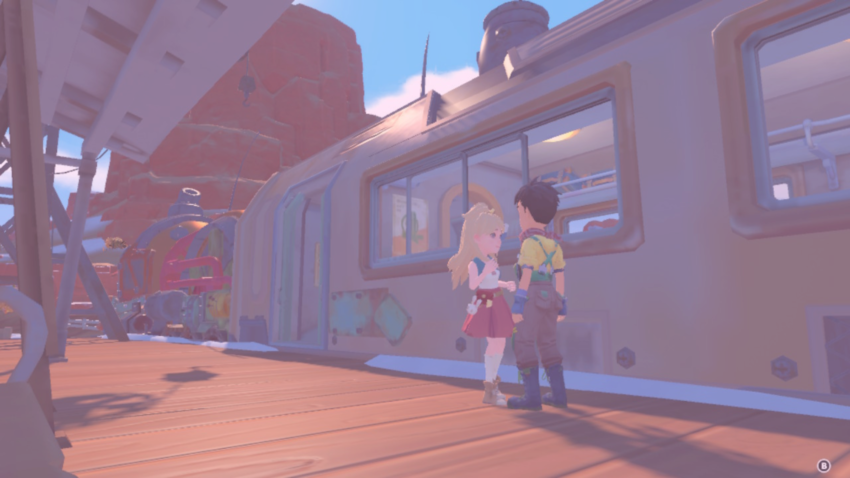Welcome to my My Time at Sandrock review! I was not given a review code for this title.
My Time at Sandrock is a resource management life sim set in a lightly steampunk frontier town sometime after a calamity took down the modern world as we know it. Partially voice-acted, the game is an ambitious sequel to My Time at Portia (released in 2019) that follows the story of two new Builders who set out to make something of themselves in a small, rustic town on the outskirts of the desert.
- My Time at Sandrock on Steam
- My Time at Sandrock on Nintendo Switch
- My Time at Sandrock on PlayStation
- My Time at Sandrock on Xbox
This review may contain minor spoilers for gameplay and story beats, though I always try not to reveal any major plot twists or surprises.
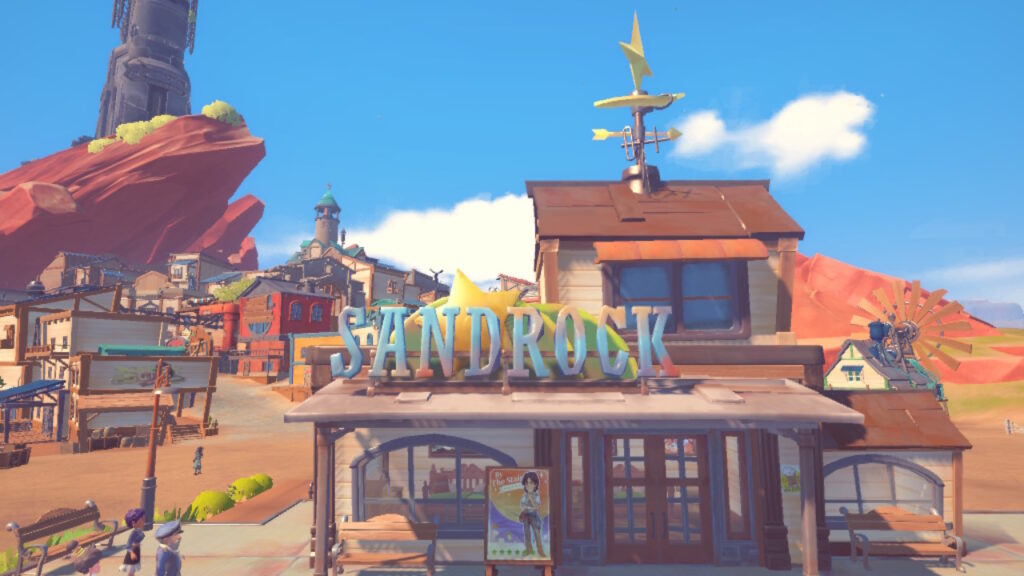
First Impressions
As soon as I booted up My Time at Sandrock, I knew I was in for a treat. It was the combination of genuinely loving My Time at Portia and just hitting that “this is the exact game for me right now” vibe. The stars aligned as my character arrived in town on a train and I met my fellow Builder, Mi-an. Everything felt so cozy, engaging, and exciting right from the get-go.
Right off the bat, My Time at Sandrock is bustling with history, intrigue, and goings-on. The town feels lively and whole. There are wanted posters bearing the face of a bandit who used to be a Sandrock resident before he “blew up a building” and took off. One of the bachelorettes has been married and divorced and is here trying to start fresh. Dangers are lurking in the desert and a trained Civil Corp works hard to protect the town. There is a weekly newspaper sent around with updates about drama, festivals, and town improvement projects. There is a camel with a loudspeaker on its saddle broadcasting public service announcements via the radio.
I was in absolute awe of how much work was put into making this world feel complete.
To say I was engrossed is an understatement. I could barely put down the game to take notes for this review. I usually listen to podcasts while cozy gaming but I had the volume up for My Time at Sandrock, as the southern accents and country-twanging instrumentals are a huge part of the charm.
I usually hustle through games so I can complete a timely review but I found myself lingering, drawing out every second with My Time at Sandrock. It had just begun and I already knew I didn’t want it to ever end.
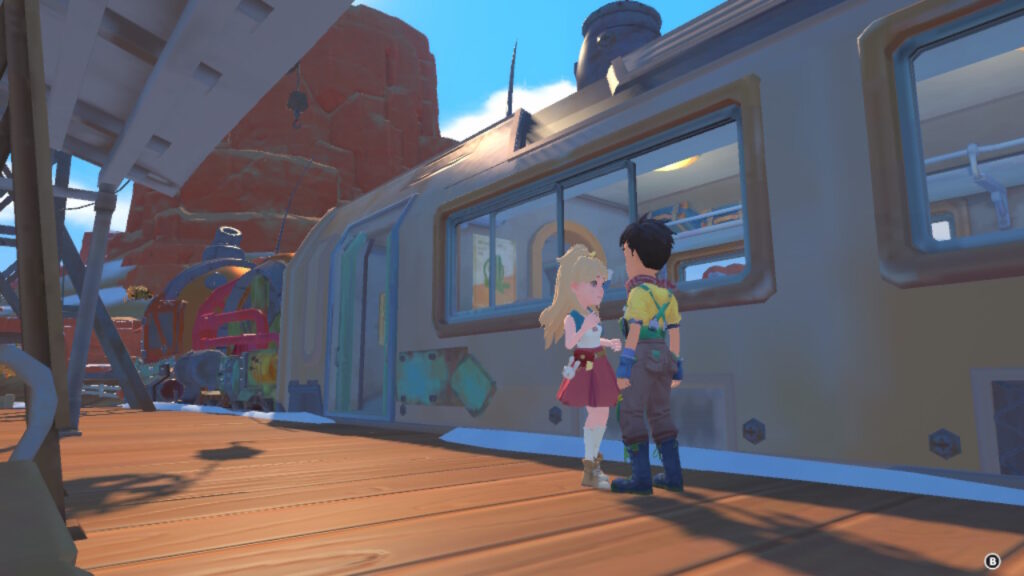
Characters & Story
My Time at Sandrock is a quaint, country experience that takes place in a setting packed with rich history, ancient mysteries, location-specific customs, and intricate national politics. Due to an unspecified calamity involving “weapons of mass destruction,” the modern, technologically inclined world was buried in rubble. Mining unveils pieces of this old world as you pick away at dirt piled in an elevator shaft or the remnants of a decrepit mall. Sometimes a sandstorm kicks up and uncovers debris from ruined cities that you can pick through for scraps.
It’s been 200 years since the disaster that reset humanity’s progress and the residents of Sandrock have done their best to carve out a little piece of heaven at the edge of the desert. Water and food scarcity play a role in the inner workings of the town, and storyline events will trigger an increase in prices if things get dire. Everything is scarce and, to hammer that point home, the town’s official motto is “Conserve water!”
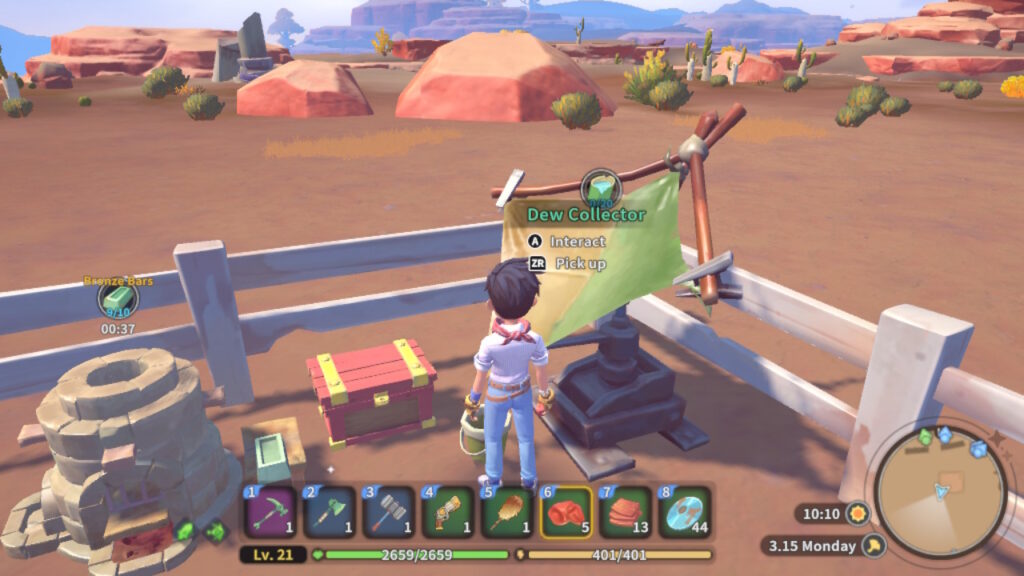
The overarching story is pleasantly rich. It’s not just character cutscenes with an end goal looming in the distance. The story isn’t static or centred around one singular objective, there are highs and lows and you can watch the cast try to solve newly arisen problems in real time. You will ride the tides of hope and disappointment with every twist and turn, watching the people of Sandrock come together to try to save and protect their home.
I honestly struggle to write anything about the overarching plot of My Time at Sandrock while maintaining a spoiler-free review. The basis of the game is that the town is struggling and you—the new Builder—are here to help with projects meant to revive Sandrock’s livelihood to what it once was. However, things are not what they seem. You’ll experience secret identities, shocking betrayals, an undercover plot, and plenty of surprise twists. Trust me when I say: it’s a wild ride.
The game will pointedly move you from one goal to the next to the next and so on; it’s extremely linear. I call this out because I want to make sure that players know that—while there are sandbox elements—this is not a sandbox game. You will be led by the hand from one objective to the next. You will watch the town change and grow around you. It was an experience I hold dear but also understand it will not be for everybody.
Honestly? The linear structure and hand-hold pacing makes sense for what the game is trying to achieve. Sure, your MC is a bit of an “self insert” but the town of Sandrock is not a “self insert locale.” The game is telling you the story of Sandrock—it’s history and people and landscape and quirks and challenges and joys. It’s not meant to be a backdrop to a story. Sandrock is the story. In some ways, Sandrock is the main character, not the player.
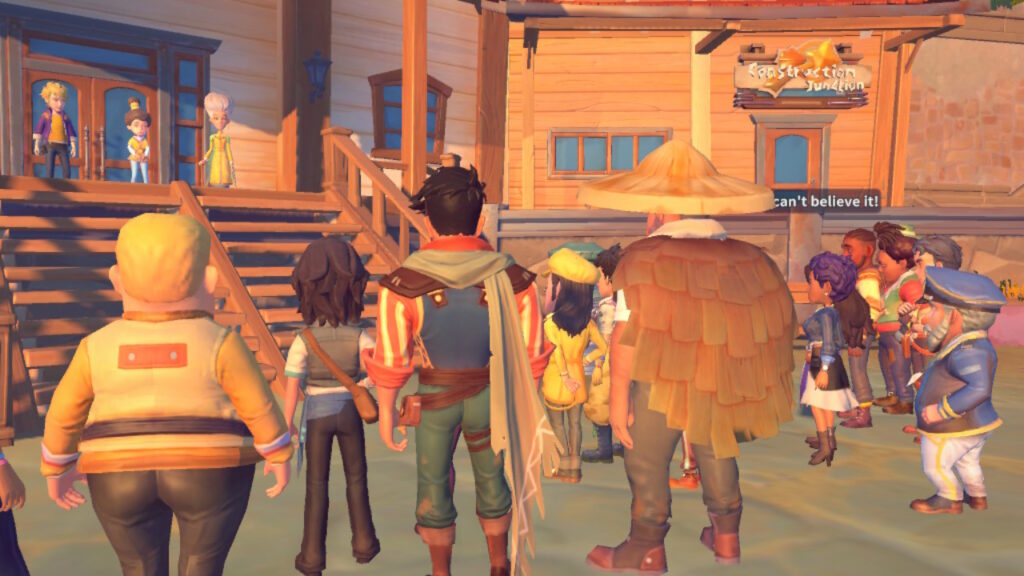
When I say the town feels alive, I don’t just mean that the characters are complex and have depth—though that’s part of it. I mean that there is always something going on. Town Hall meetings every Sunday. Story time at the local saloon every Saturday night. Live music at the public stage. Church service every Sunday morning, with nearly the whole town in attendance.
The game is designed in a way that makes you feel as if Sandrock will continue living and thriving, even without the player there. This contributes to a rich and satisfying sensation of “I am a part of this community” rather than “I am the only agency in this community.” I loved feeling like things were happening all around me and I could pop in and take part if I choose.
The seasonal festivals will even commence without you if you are running late or distracted. While this definitely speaks to the town feeling self-sufficient, I admittedly could have used a bit of leniency here. I missed festivals, events, and ceremonies simply because I was across the map and running an hour late. The time sensitivity, while realistic, could have been toned down a bit for major events.
I love that Sandrock is a living, breathing town full of vibrancy and agency—but wish that didn’t mean I miss out on a key cutscene because I had to stop my cat from eating plastic and left the game unpaused in my panic (true story).
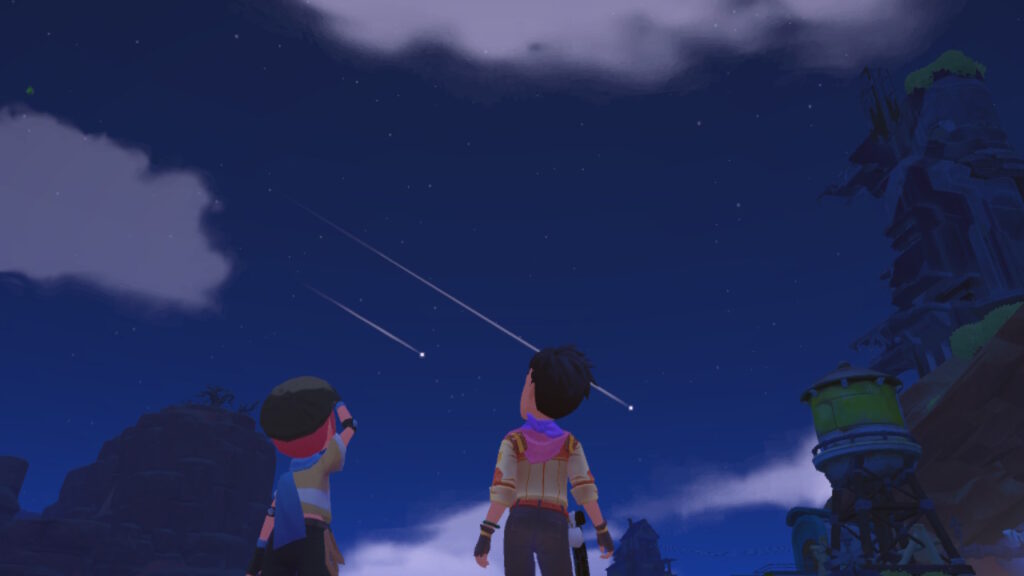
Additionally, the social system is a bit tricky and convoluted. Not only can it be hard to find people on the map (there is an unlockable skill for this but only if you are friends with the person already) but NPCs can sprint at a speed your avatar can’t match. You’ll try to catch Mi-an in the field to offer her a home-cooked meal and she will rocket off like her rear is on fire.
Then, there is gift giving: liked gifts are hard to come by early in the game and even if you secure what you need, giving the same gift too many times in a row has a lessened friendship effect. Neutral gifts can net you anywhere between 1-4 relationship points; loved gifts will earn you 5+. It’s a lot to keep track of and manage, particularly as there is so much else to do in the game.
I think I was disappointed with the social system simply because the game is so activity-packed that these elements fall to the wayside even though I genuinely want to spend time with every single person in town. Even the unlikeable ones! The curmudgeonly ranch owner, Cooper; the flirtatious playboy, Arvio; the bumbling but lovable church devotee, Burgess—there wasn’t a single character I didn’t want to get to know more.
My Time at Sandrock also does something very interesting with NPCs in that many of them have significant story arcs that affect how you interact with them indefinitely. I don’t want to give away any spoilers so I’ll just say this: character developments are not treated as mere cutscenes. They play a pivotal role in the story from the point you unlock them forward. You will uncover secrets and see people grow and change around you in a permanent and meaningful way.
You’ll find the game has tons of little moments like this. Special moments crafted with love that will continue to surprise you as you dive deeper into the story.
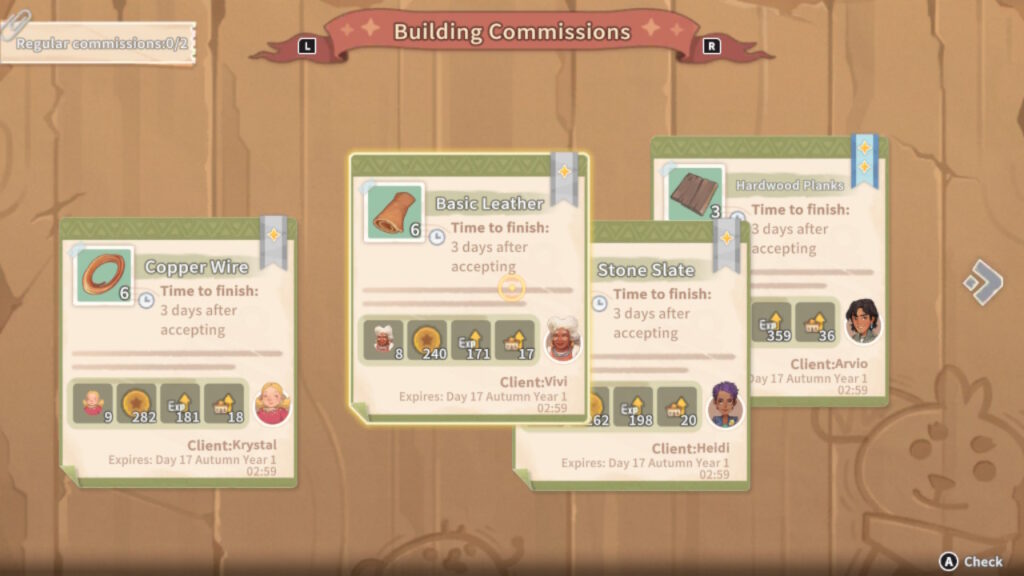
I always hate to say this about games but My Time At Sandrock overstayed its welcome by about 20 hours in the third act. I know, right? Who complains about “too much” game? But the game provided a more-than-satisfying finale at around the 2/3rds mark. There’s a dungeon, a revelation, a battle, a wrap-up. And then the game keeps going…and going…and going. I understand wanting to tie up loose ends but I think the game could have benefitted from streamlining everything after what essentially feels like the final boss fight (end of act two; ~90-95 hour mark for me).
That being said, I can confidently say you are getting your money’s worth with My Time at Sandrock, even if you buy it at full price. I “hurried” through the game for the sake of this review but I could have added hours to the clock exploring, reaching the bottom of all the mines, befriending more of the townsfolk, and upgrading my workshop and home. There is a ton of content for what you get, and most of it shines like gold.
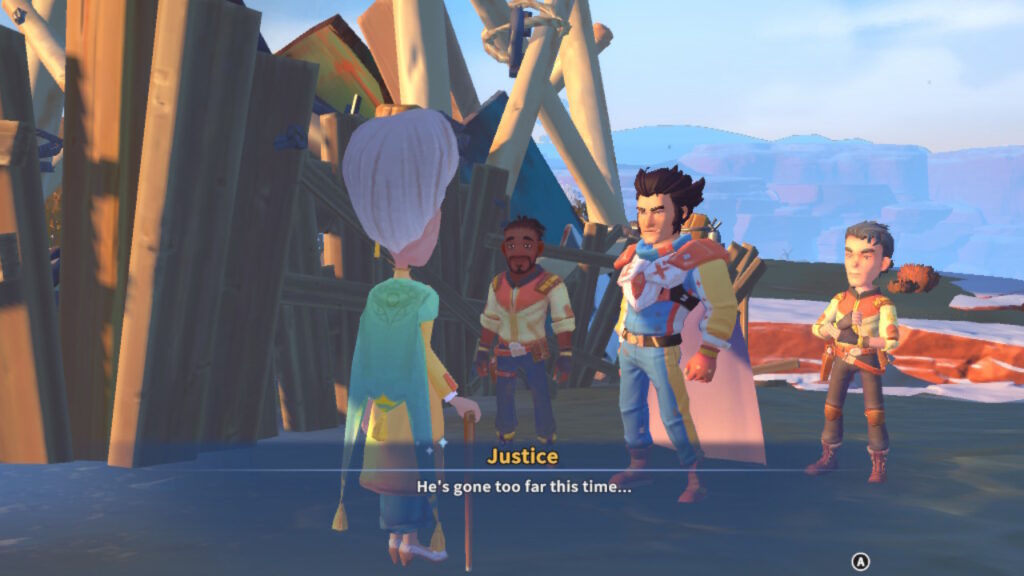
Gameplay Loop
My Time at Sandrock is primarily a resource management and crafting game. There are farming elements but they are not available right away and they are relegated to the background importance-wise. There is also a vibrant cast of characters with whom you can chat, exchange gifts, go on elaborate dates, and even spar. You will spend most of your time visiting a variety of distinct areas looking for wood, stone, rubber, and mechanical components.
As a Builder, you use your Assembly Station to construct machines for processing gathered resources into usable parts. Most of your time will be spent completing various commissions around town for Gol (currency) and improving the reputation of your workshop. The main story will toss you some bigger projects here and there, which will progress the plot piece by piece.
One of my favorite parts: My Time at Sandrock has a rather unique take on their mining system. You are given a jet pack and a radar device and—with your trusty pickaxe—can set about digging into various mountains of earth. You can dig down, up, sideways—anywhere you can conceivably reach. As the land is carved away, you can hunt for artifacts, ore, the occassional bandit rat, and doors. You keep making paths, mining ore, and uncovering treasures the deeper you go, later by layer and floor by floor.
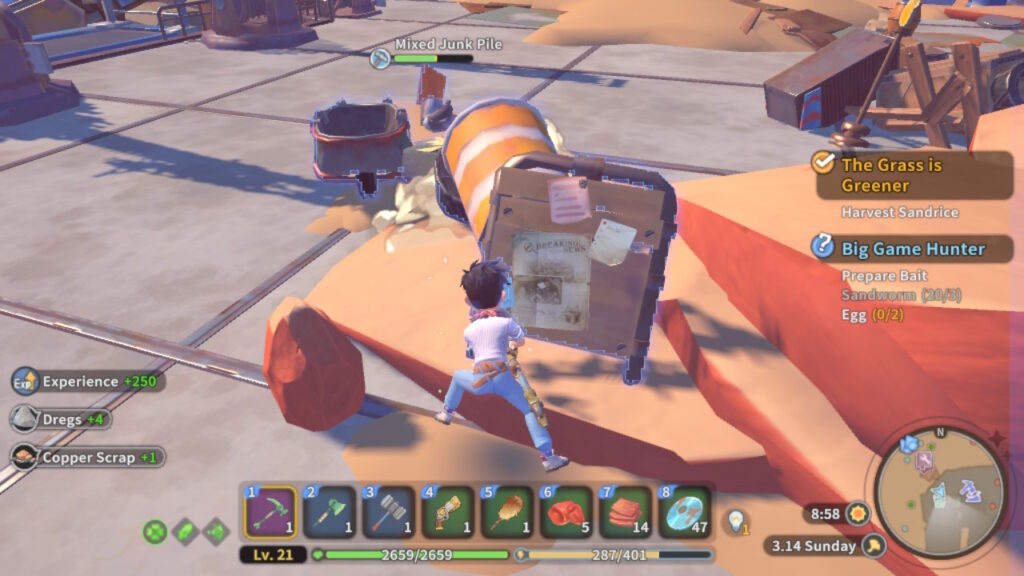
I love the approach the game takes to mining. Having it be so much more involved than other games helps to highlight that My Time at Sandrock is fundamentally a game about harvesting resources. However, the game struggles to nail the mining controls. The nature of the “any direction” movement in small spaces results in the camera struggling to stay focused; similarly, it can be hard to target areas with your pickaxe because you have to be positioned just so and movement is tight and imprecise.
You will have tons of mines and ruins to explore, each that will open alongside key moments in the main story. Then you can spelunk to your heart’s content. You can also just wander around the desert landscape looking for rocks, stumps, scrap piles, or monsters to farm items. There is a ton to know and remember so don’t feel bad if you have to write things down (where do I farm microchips again?) or lean on a wiki.
The game does a good job of cataloguing all of your resources and items. You can hover over the icons and learn where you can find them, so it’s a bit of a built-in wiki, which can come in quite handy. There are plenty of quality-of-life mechanics like this that I could shout out. Your horse follows you around after you ride him the first time each day; all your storage chests are “connected” so you can scroll through them and sort items without opening and closing menus; you have a generous amount of inventory (bag) slots that you can add to at your leisure; et cetera.
One thing to note: There is quite a bit of combat in the game. The combat doesn’t feel great but it’s manageable. You can craft and upgrade weapons and equipment, cook or buy stat-boosting meals, level up a combat skill tree, and even decorate your house with items that provide permanent buffs. All of this to say, the combat is made quite easy for the majority of the game so I wouldn’t worry too much about it right away. However, there is an odd difficulty spike right at the end to be aware of.
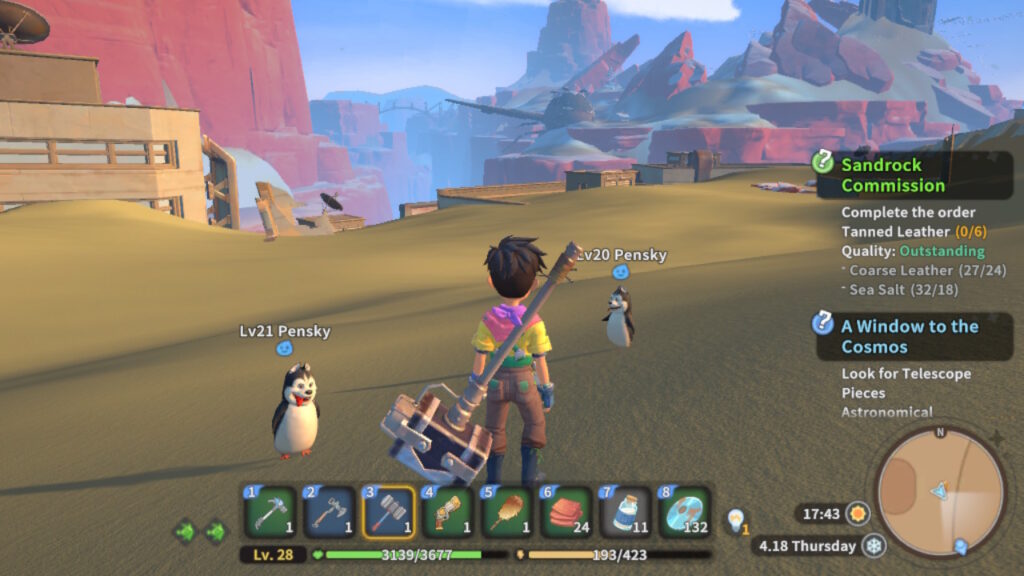
The other major gameplay element I wasn’t hot on was the enormous amount of overly complex minigames. Highly involved, mediocre minigames show up everywhere. They pop up at festivals, in story events, as a date night activity, as a part of side quests… You’ll race sleds, hammer whack-a-moles, collect gifts, hunt ghosts, jive with a rhythm game, and more. It’s…a lot. Most of them were neither fun nor mandatory so I skipped them where I could.
If I could describe my final thoughts on the game it would be this ever-useful cliche: It has very high highs and very low lows. However, the “lows” are mostly non-critical to completion, except for a few instances of mandatory finicky platforming and combat. Overall, My Time at Sandrock has a solid 100+ hours of addictive entertainment (I clocked in at just over 125) centred around collecting, building, and socializing in a world that draws you into its rich, dark lore like a siren’s song.
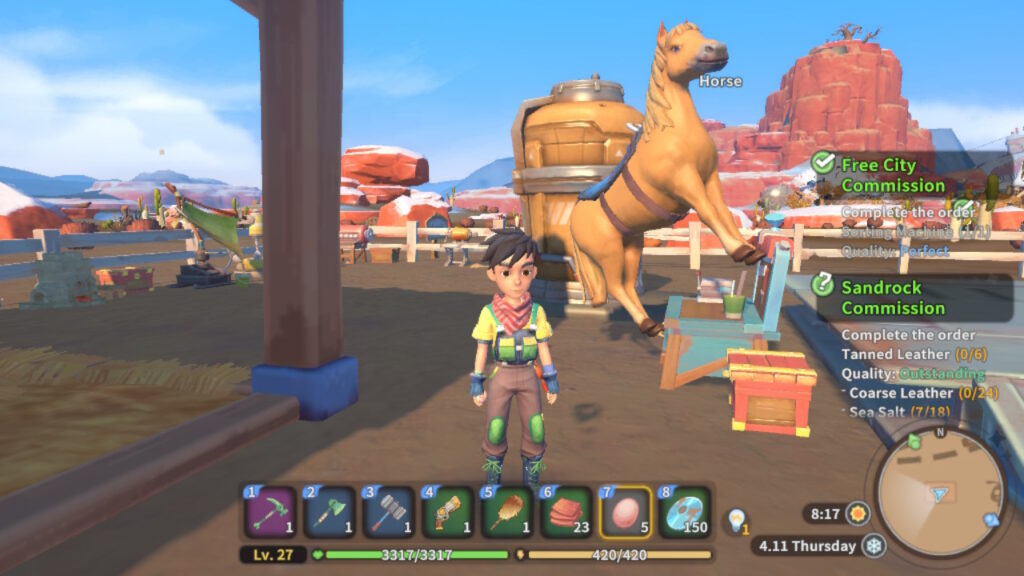
Technical Issues
The moment of truth: Does My Time at Sandrock work well on Nintendo Switch? As you may recall, My Time at Portia had so many known issues on the Switch version that fans warmed others to play it elsewhere. Unfortunately, My Time at Sandrock has many of the same problems, with the game running and loading poorly, cutscenes glitching, and activities scaled down to speak to the lower power of the hardware.
I played the game on Nintendo Switch to test it and here are some of the issues I encountered:
- Gameplay lag and stuttering
- Minister Matilda’s character getting stuck in “T pose” often
- Character movement stuttering when there are too many avatars on screen at once
- Assets populating very slowly on screen
- Excruciatingly slow menu screen when switching tabs
- Occasion “memory low” warnings where restarting the game was the recommended fix
- Two soft locks triggered by events in the game
That being said, many of these issues may be resolved by simply…not playing the game on Nintendo Switch. It’s unfortunate, as handheld gaming in bed is peak cozy, but with the launch of the Steam Deck there is nearly no need to play games on outdated (albeit cheaper) tech.
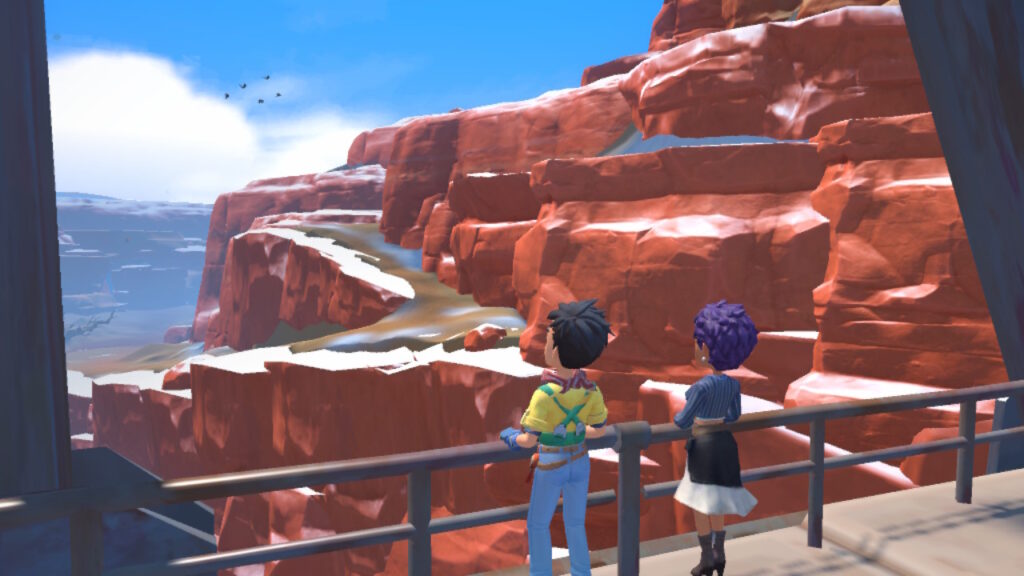
Summary
Short on time (or attention span)? Here is the TLDR of this My Time at Sandrock review:
Pros
- World packed with activity and lore
- Extremely satisfying gameplay loop with so much to do your head will spin
- Creative and engaging mining experience
- Colorful cast of characters and a quaint town that’s genuinely hard not to adore
- A unique, engaging story with tons of twists and turns
Cons
- Convoluted friendship/gift-giving system
- Finicky camera controls, particularly in the mines
- Too many busywork minigames
- Events and festivals are extremely time-sensitive
- The third act drags on a bit too long
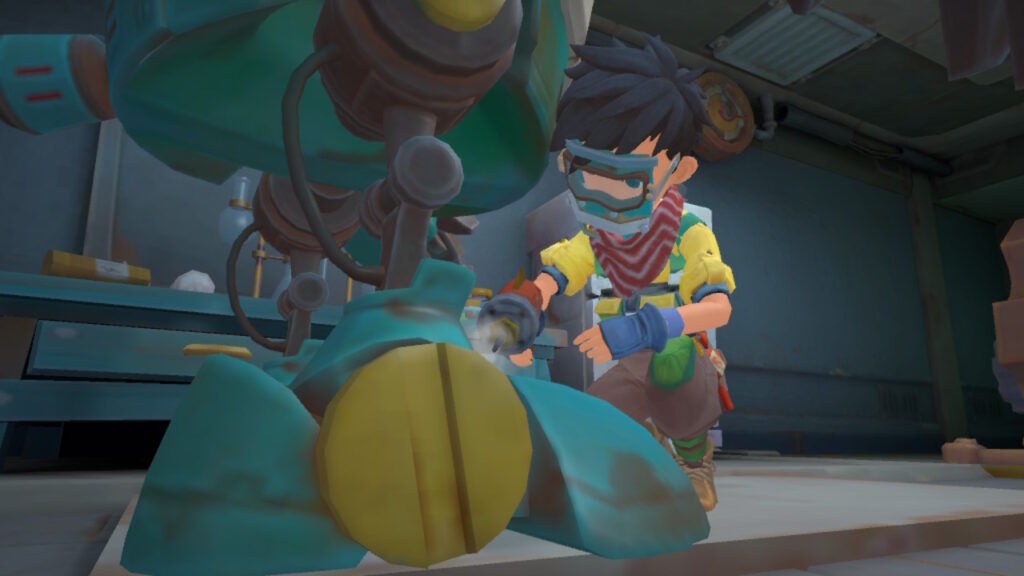
Conclusion
My Time at Sandrock is a large, wondrous, and ambitious game about crafting and community. The story is deep and engaging in ways you won’t anticipate. The cast of characters is the best and brightest I’ve seen in a cozy game for a while. It has its ups and downs, for sure, and it won’t be for everyone, but I can confidently say it is worth a playthrough if you enjoy this type of game.
I would recommend buying My Time at Sandrock at full price. It is well worth the dollars spent. Just don’t buy the Nintendo Switch version, as it vastly underperforms compared to PC, PlayStation, and Xbox editions.
Who My Time at Sandrock is for…
- Folks who loved My Time at Portia
- Players looking for cozy games that aren’t farming-centric
- Those who enjoy rich world lore and dynamic NPCs
- Those who love collecting and cataloguing mechanics
Who My Time at Sandrock is not for…
- Nintendo Switch gamers
- Players looking for a farming sim fix
- Those with minigame phobia
- Those with bad memory/wiki aversions
Stay cozy, gamers!
